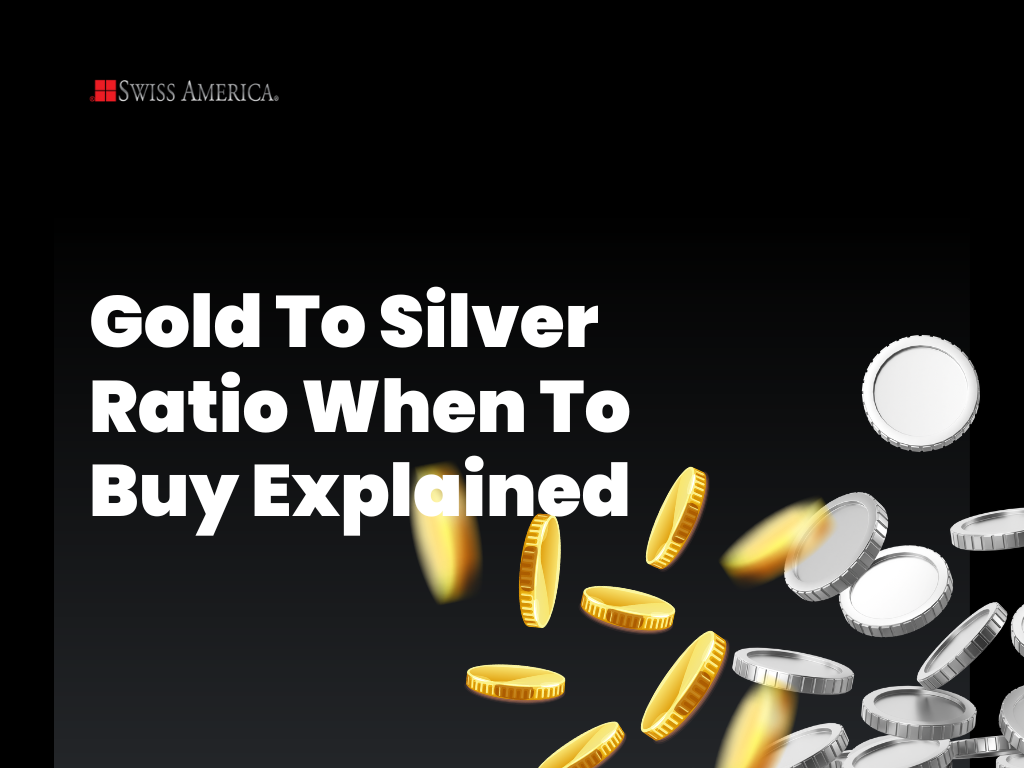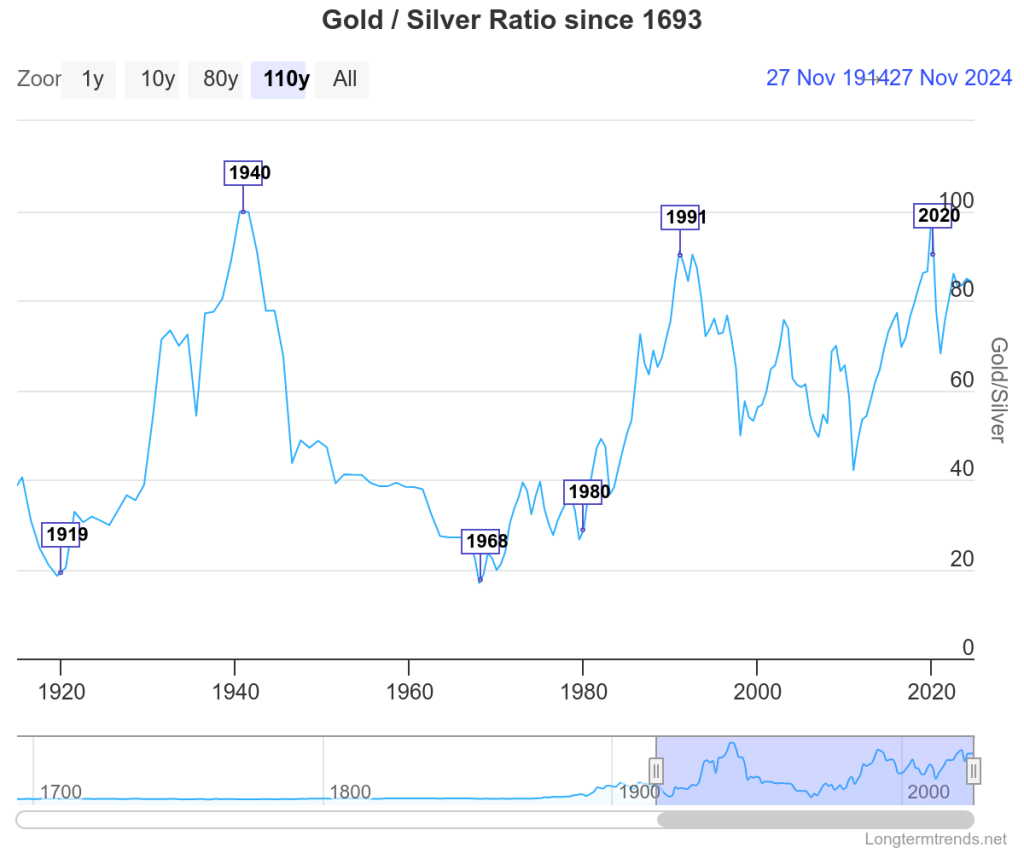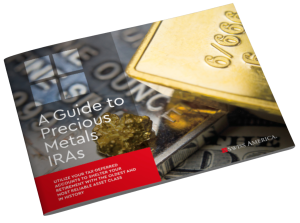
As of this writing, gold is $3,800/oz, and silver is $47/oz. If you are looking at these two precious metals, which one do you buy?
People use the gold to silver ratio when to buy either metal investment at any given time. This metric show how the prices of gold and silver compare and change over time. Many precious metals traders and investors watch this ratio closely to help them spot opportunities.
In this article, we’ll explain how to use the gold-to-silver ratio when to buy precious metal assets.
How does the gold-silver ratio work?
The gold-silver ratio shows how many ounces of silver can buy one ounce of gold. People use it to show the value of gold vs silver over time.
You might use this ratio to decide when to buy either metal since it provides a quick comparison. If you see that one metal is undervalued versus the other, you might decide that’s the right time to buy.
To calculate the ratio, divide the current gold price per ounce by the price of one ounce of silver. For example, if gold is $2700/oz and silver $33/oz, you would calculate the ratio like this:
$2700/$33 = 81
So, it takes 81 ounces of silver to equal the value of one ounce of gold.
Longtermtrends keeps a live chart on its website that allows you to see the ratio for varying historical timeframes:

Gold silver ratio history
In the past, governments seeking monetary stability set the ratio. For example:
Roman Empire: This government set the ratio at 12:1, meaning 12 ounces of silver equaled one ounce of gold.
U.S. government: In 1792, our government instituted the Coinage Act, setting the ratio at 15:1. In the 19th century, the U.S. used a system called bimetallism. This system tied both gold and silver to the value of money. Part of this system included government control over the exchange rates of both metals.
Things began to change in the 20th century when countries moved away from these fixed systems. First, they left bimetallism and eventually dropped the gold standard altogether. We speculate today whether we’ll see a currency reset but as of right now, these metals trade unrelated to currency.
Once gold and silver started trading freely, their prices became much more unpredictable. Instead of a fixed ratio, the value of gold compared to silver began changing based on the market. Factors like supply, demand, and overall economic conditions determine prices.
Why the gold-silver ratio changes
Gold and silver prices don’t always move the same way, which is why the ratio keeps changing. Here’s a comparison of the two:
Different market sizes
At a market cap of $17.9 trillion, the gold market is much bigger than silver’s $1.76 trillion. So, when people sell or buy silver, it can cause a larger price change. The chart below from Grandview Research also shows the estimated compound annual growth rate for gold, silver, and platinum through 2030, with the overall market expected to grow at 6.4% annually.

Different uses
People use gold as a safe haven to store wealth or to provide protection against uncertainty.
Silver is also a store of wealth but has a larger range of industrial uses like mobile phones, solar panels and medical equipment. This makes the overall price depend more on the demand from these industries.
Reacting differently to world events
During chaos and crisis events, people rush to buy gold for safety. For example, prices rose around 53% over the 14 months following the beginning of the pandemic.
Silver didn’t see the same rush, so the ratio between their prices changed significantly.
Uneven gold and silver price movements
Each metal operates independently which is why investors like having both in their portfolio. Even when both metals’ prices go up or down, they usually don’t do it by the same amount. The ratio will change if gold goes up a little, but silver goes up a lot.
Trading gold-silver ratio
Some investors use the approach of trading the gold-silver ratio. It’s a strategy to increase their metal holdings over time. Here’s how it works:
Start with some gold.
When the ratio is high trade your gold for silver.
Wait until the ratio drops, and trade your silver back to gold.
The goal is to end up with more metal than you started with. If you begin with 1 oz of gold, you could end up with 2 oz after a full cycle.
Why do this? Some people see it as a hedge against inflation or currency devaluation. They focus on accumulating more metal rather than increasing dollar value.
This strategy requires patience and careful timing. It’s not about quick profits but rather a long-term approach to potentially growing your precious metal holdings.
Ways to invest in gold and silver
Here are some ways to invest in these precious metals:
Exchange-traded funds (ETFs)
Some investors use silver or gold ETFs to invest in gold and silver without buying the metals themselves. The challenge with funds is that they are paper assets. Most silver bullion or gold investors prefer actually owning tangible assets to give them the best protection against uncertainty and economic risks.
Futures and options trading
Futures and options are agreements to buy or sell gold or silver at a set price on a future date. You can make money from changes in the prices of gold and silver compared to each other by trading futures. It’s a risker approach that can cause great losses and you still don’t own a tangible asset.
Physical gold and silver
Buying actual gold and silver bullion means owning the real metals. This investment strategy gives you the full benefits of owning a tangible asset. With this approach, you control the asset without relying on any third party. You also reduce your risks from cyber attacks or issues since you don’t need an internet connection or secure password to access your metals.
Owning gold, silver, or other precious metals means that you’ll need to consider storage and insurance costs as part of your overall returns. You can see others’ opinions on physical gold like Oddah on Reddit’s r/Gold forum who asked:
“Do you guys buy actual physical gold or just the stocks?”
Responses varied:
7777777King7777777 emphasized physical ownership: “The only thing that truly belongs to you is the gold that you hold in your hand!”
Bi_partisan_Hero recommends a diversified approach: “Physical gold is good because you hold it, digital gold is good for liquidity, and gold mining stocks are good for growth in a gold bull market. Despite what people tell you, I prefer to own all of the above.”
Limitations of using the gold-silver ratio
Trading based on the gold-silver ratio can help grow your metal collection, but it’s not always easy. One big issue is knowing when the ratio hits its highest or lowest points in history.
For instance, you might sell gold for silver when the ratio hits 100. But if it goes up to 120-150 and stays there for years, you could be stuck with silver and miss out on the better deals.
Markets can also change their usual patterns. You might need to change your plan if the ratio reaches new extremes. There’s no promise that the ratio will return to old levels, so you’ll have to keep a close eye on it over time.
In short, the gold-silver ratio can help guide your trades, but you need to watch it and be ready to adapt.
Working with Swiss America to buy gold and silver
If you are looking to buy gold, silver, or other precious metals, be sure to choose a reputable dealer like Swiss Amercia. We’ve been around for over 40 years and have helped thousands of happy customers with their physical precious metal investments.
When you work with our team, you can expect:
Professional guidance: We provide expert advice on secure storage solutions, precious metals IRAs, and understanding market trends so you can make the best decisions about your investments.
Transparent and fair pricing: We offer competitive and transparent pricing so you’ll always know exactly what you’re paying for your metals.
Buy-back program: Take advantage of our buy-back program to sell your metals back to us if you want to trade between gold and silver.
Online visibility: You can check your account at any time to see the value of your holdings and purchase and sell history.

Gold silver ratio final thoughts
The gold-to-silver ratio can be a guideline but don’t rely on it alone when deciding what to buy. You should also consider other things like how the market is doing overall, what you want from your investments, how much risk you’re okay with, and what’s happening in the world economy and politics.
The best time to buy depends on your financial situation and what you want to achieve. The gold-to-silver ratio can help, but you should also consider the bigger picture of the market and your own needs.
If you’re ready to explore your options, contact Swiss America today for the best advice and different precious metals investments.
Gold to silver ratio when to buy: FAQ
What is the gold-to-silver ratio right now?
The gold-to-silver ratio changes daily as prices move. It’s usually between 60:1 and 80:1. This means one ounce of gold is worth 60 to 80 ounces of silver.
When to swap silver for gold?
Think about trading silver for gold when the ratio is high, usually above 80:1. This means silver is cheaper than gold, so you might get a good deal trading silver for gold. But also consider your money goals and what’s happening in the fold and silver market before deciding.
When should I buy gold and silver?
The best time to buy depends on your goals and the market’s conditions. Silver might be a good buy if the ratio is high (over 80) because it’s cheaper than gold. Gold might be better if the ratio is low (under 50).
Note: The information in this post is for informational purposes only and should not be considered tax or legal advice. Please consult with your own tax professionals before making any decisions or taking action based on this information.
